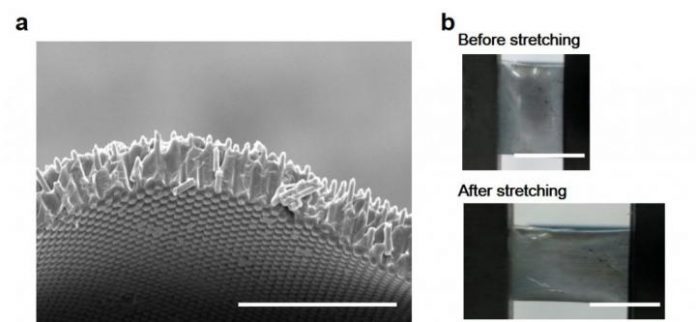Researchers at South Korea’s Ulsan National Institute of Science and Technology (UNIST)have developed a stretchable colorless solar cell with a claimed conversion efficiency of 8% which they say can maintain around 95% of its performance after dozens of bending tests.
The device, conceived for use in buildings, vehicle glass and portable electronic devices, is described in the paper Stretchable and colorless freestanding microwire arrays for transparent solar cells with flexibility, published in Nature.
The colorless cell was made by embedding cylindrical silicon rods in a flexible, transparent polymer. The freestanding silicon-microwire-array polymer composite film (SiMPF) was obtained through a combination of dry and wet etching. “A hexagonal array of microwires with a diameter of 2μm and a length of 30μm was fabricated by a photolithography process involving reactive ion etching,” the researchers said.
Large surface area
The UNIST group applied an aluminum oxide (Al2O3) layer onto the silicon microwire using atomic layer deposition (ALD) to passivate the silicon surface. “Compared to conventional silicon solar cells, the freestanding SiMPF-based transparent solar cells in this study have a very high surface area; thus, proper surface passivation is essential,” the researchers stated.
The group then used spin-coating to embed the silicon microwire (SiMW) array in polydimethylsiloxane (PDMS), the most widely used silicon-based organic polymer. “We found that the Al2O3-coated SiMW array was so hydrophobic that PDMS could not deeply penetrate the SiMW and the adhesion between SiMW and PDMS was not very strong,” reported the researchers. “Thus, PDMS was easily peeled off the SiMW array in the second spin-coating step.”
Microwires
The microwire arrays used for the cells are said to be advantageous for the formation of effective junctions, allowing for easy carrier collection. The researchers said their neutral-color transparent solar cell based on slanted-tip SiMPFs demonstrated a conversion efficiency of 8.07% at 10% average transmittance. The device’s enhanced light absorption performance, they said, was due to the re-absorption of light by adjacent silicon microwires and an enhanced electric field in the microwires themselves.
“The transparent solar cell in this study is an ideal that can be utilized in real-world applications such as building-integrated photovoltaics, automobile attachable devices or … internet of things [applications] in the future,” said the UNIST team.
A stretchable solar cell was unveiled by researchers at Saudi Arabia’s King Abdullah University of Science and Technology in January. The Saudi group claimed to have stretched a crystalline silicon cell’s surface by around 95% while maintaining conversion efficiency of approximately 19%.
In December, other UNIST researchers said they had transformed an opaque crystalline silicon solar cell into a transparent one by punching 100μm-diameter holes into it. A neutral-colored, transparent c-Si substrate was reportedly used to develop the cell, which was said to have an efficiency of up to 12.2%.






